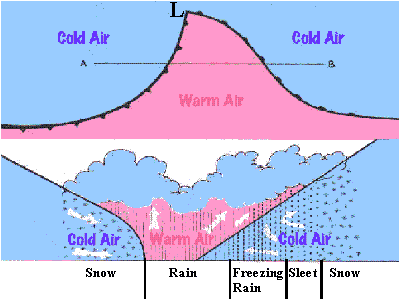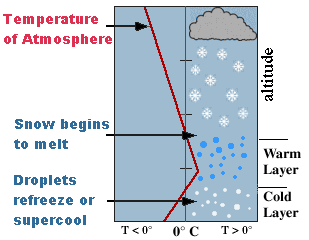 |
 |
| Home | Welcome | What's New | Site Map | Glossary | Weather Doctor Amazon Store | Book Store | Accolades | Email Us |
 | |||||||||
Hard Rains Will FallWhen you mention winter precipitation to most North Americans, the first image that generally come to mind is one of snow. But often along the winter storm fronts where the forces of warm and cold air clash, precipitation may fall in a variety of forms other than snow and rain, even if for only a brief interval. Other forms of hard rain can fall as well, even from a clear blue sky. 
Rain and snow, you see, are not the only members of the winter precipitation congregation, just the most common. The other winter members include: freezing rain and drizzle (glaze or hard rime), soft rime, ice pellets, ice crystals, ice needles, snow grains and graupel. They are also known by a variety of local names in different regions: sleet, hail, soft hail, snow pellets and diamond dust. 
Almost all forms of hard rain begin as ice/snow crystals in clouds. If, as they descend, they traverse a layer of air with above-freezing temperatures, they can melt or partially melt depending on the depth of the layer and its departure from freezing. If they do not next enter a subfreezing air layer, then they fall as rain or a mixture or rain and snow. But if they pass through a layer of subfreezing air before hitting the surface, they may refreeze, partially refreeze, or perhaps supercool. And if the falling particles are caught in a series of updrafts and downdrafts and make multiple passes through the warm and cold layers, they may collect several layers of ice like a hail stone. The two exception to the above are ice crystals and ice needles which are special forms of snow.
Ice Pellets or Ice Grains are clear or opaque hard ice particles, spherical or irregular in shape with diameter of 1-5 mm (0.04-0.16 inches) They are formed by the re-freezing of rain or drizzle drops or partially melted snowflakes falling through a cold air layer near the surface. Often called sleet in United States, they bounce when hitting a hard surface.
Snow Grains are white opaque particles, either flat or elongated, and less than 1 mm in length, the solid equivalent of drizzle. Smaller and flatter than snow pellets, they generally fall from stratus clouds rather than in convective clouds. Sleet is a term for cold weather precipitation that has a few different meanings. In the US, it refers to ice pellets, but is sometimes erroneously used to mean freezing rain. In UK, sleet refers to mixed rain and snow or melting snow. Our final forms of hard rain are rime and glaze. There are two forms of rime: hard and soft. Hard rime and glaze are more technical subcategories of freezing rain or drizzle. Both are formed by supercooled drops which freeze on contact with a cold surface. Temperatures and rates of fall determine whether freezing rain/drizzle is comprised of glaze ice or rime ice.
Hard rains may fall either as showers or continuous precipitation, but some forms fall in a preferred manner. Like snow and rain, ice pellets may fall continuously or in showers. Freezing rain/drizzle, snow grains and ice crystals usually fall as steady precipitation whereas showers are the dominant method of fall for graupel -- snow pellets and soft hail. Soft rime generally deposits on surfaces rather than falls. "A hard rain's a-gonna fall," Bob Dylan told us in the 1960s -- although he was actually referring to the threat of radioactive fallout from a nuclear war. But I am sure Dylan, a native of Minnesota, experienced his share of hard winter rains, the type of the sort have fallen upon the earth since early earth history and they continue to do so in the winter months when the water of rain turns to hard ice. Learn More From These Relevant Books
|
|||||||||
 |
To Purchase Notecard, |
Now Available! Order Today! | |
 |
 |
NEW! Now Available in the US! |
The BC Weather Book: |


